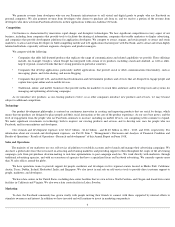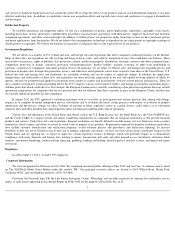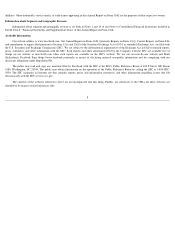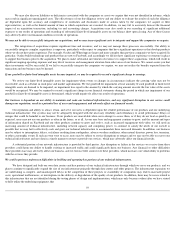Facebook 2014 Annual Report Download - page 18
Download and view the complete annual report
Please find page 18 of the 2014 Facebook annual report below. You can navigate through the pages in the report by either clicking on the pages listed below, or by using the keyword search tool below to find specific information within the annual report.
We expect our rates of growth to decline in the future.
We expect that our user growth and revenue growth rates will decline over time as the size of our active user base increases and as we achieve
greater market penetration. For example, the growth rate of Facebook's MAUs declined from 25% from 2011 to 2012, to 16% from 2012 to 2013, to
13%
from 2013 to 2014. Historically, our user growth has been a primary driver of growth in our revenue. In addition, we expect our revenue growth
rate will generally decline over time as our revenue increases to higher levels. As our growth rates decline, investors' perceptions of our business may be
adversely affected and the trading price of our Class A common stock could decline.
15
•
our ability to attract and retain marketers in a particular period;
•
fluctuations in spending by our marketers due to seasonality, such as historically strong spending in the fourth quarter of each year, or
other factors;
•
the number and quality of ads shown to users;
•
the pricing of our ads and other products;
•
our ability to maintain or increase Payments and other fees revenue;
•
the diversification and growth of revenue sources beyond advertising and Payments;
•
the development and introduction of new products or services by us or our competitors;
•
increases in marketing, sales, and other operating expenses that we will incur to grow and expand our operations and to remain
competitive;
•
our ability to maintain gross margins and operating margins;
•
costs related to the acquisitions of businesses, talent, technologies, or intellectual property, including potentially significant amortization
costs and impairment loss and additional investments to further develop the acquired technologies;
• our ability to obtain equipment and components for our data centers and other technical infrastructure in a timely and cost-
effective
manner;
•
system failures, which could prevent us from serving ads for any period of time, or breaches of security or privacy, and the costs associated
with remediating any such failures or breaches;
• inaccessibility of our products due to third-
party actions;
• share-based compensation expense, including acquisition-
related expense;
• adverse litigation judgments, settlements, or other litigation-
related costs;
•
changes in the legislative or regulatory environment, including with respect to privacy, or enforcement by government regulators, including
fines, orders, or consent decrees;
•
the overall tax rate for our business, which may be affected by a number of factors, including the financial results of our international
subsidiaries and the timing, size, and integration of acquisitions we may make from time to time;
•
tax obligations that may arise from changes in laws or resolutions of tax examinations that materially differ from the amounts we have
anticipated;
•
fluctuations in currency exchange rates and changes in the proportion of our revenue and expenses denominated in foreign currencies;
•
fluctuations in the market values of our portfolio investments and in interest rates;
•
changes in U.S. generally accepted accounting principles; and
•
changes in global business or macroeconomic conditions.
























